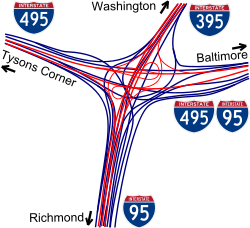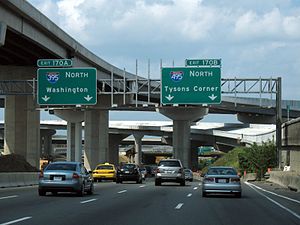- Springfield Interchange
-
Springfield Interchange 
The old Springfield Interchange (in red) superimposed over the new Springfield Interchange (in blue) and the new HOT lanes (in orange)Location Springfield, Virginia Coordinates: 38°47′28″N 77°10′34″W / 38.791°N 77.176°WCoordinates: 38°47′28″N 77°10′34″W / 38.791°N 77.176°W Roads at
junction: I-95
I-95
 I-395
I-395
 I-495
I-495
Various local roadsConstruction Type: Interchange Constructed: 1960s Maintained by: VDOT The Springfield Interchange, also known as the Mixing Bowl,[1][2] is the interchange of Interstate 95, Interstate 395, and Interstate 495 in Springfield, Virginia, outside of Washington, D.C.. The interchange is located at exit 57 on the Capital Beltway and exit 170 on I-95.
This interchange is nicknamed the "Mixing Bowl" because, prior to the reconstruction, local and long distance travelers shared the same lanes and travelers had to merge to the right or left to reach the correct lanes for their destination. The last of this weaving and merging was eliminated on April 21, 2007. The interchange is one of the busiest highway junctions in the U.S., serving about 430,000 cars per day.[3]
Contents
History
The interchange was originally built in the 1960s as a simple interchange between I-95 and the Capital Beltway. At the time, I-95 was expected to go through the District of Columbia. After community opposition prevented its construction through the city, I-95 was shifted to the eastern portion of the Beltway, between Springfield and College Park, Maryland. Because of this route change, all traffic continuing on I-95 through the Washington area was exiting at Springfield through an interchange not designed for that purpose. By early 1970, there were 150,000 vehicles per day traveling through the intersection. Thirty years later, that number had more than doubled, with the effect that vehicles "traveling along the East Coast's main north–south artery [had to] be funneled through the ordinary exit ramps at Springfield, routinely causing backups several miles long."[4]
A study by the National Highway Traffic Safety Administration determined the interchange to be the site of 179 crashes between 1993 and 1994—more than any other spot on I-95—and found that the number of ramp accidents was more than double that of any other Beltway interchange.[4]
Major reconstruction (1999–2007)
In March 1999, the Virginia Department of Transportation (VDOT) began an eight-year, seven-phase reconstruction project, which also involved the reconstruction of the I-95/Route 644 interchange. The project was one of the largest highway construction projects in the U.S., costing $676 million.
Phase 1
Completed 1996
- Add another lane to southbound Interstate 95.
Phases 2 and 3
Completed November 2001
- Reconstruct the I-95/Route 644 interchange.
- Make the I-95 Northbound entry ramp from eastbound Route 644 enter on the right.
- Reconstruct the Commerce Street bridge.
- Improve the Amherst Street bridge.
- Construct a flyover from westbound Route 644 onto I-95 south and therefore demolish the original cloverleaf that served this purpose
- Add an express bridge for Route 644
- Make the I-95 North ramp onto Exit 169 separate from I-95
- Add a cloverleaf ramp from I-95 North onto Route 644 westbound
- Construct a bridge from eastbound Route 644 onto the I-95 HOV Lanes (northbound only).
- Reconstruct the I-95 HOV Lane ramp (southbound only) onto Route 644 westbound.
Phase 4
Completed October 2004
- Relocate the Outer Loop, eastbound I-495, of Interstate 495 where it crosses I-395, this time making it a higher bridge.
- Add a two-lane flyover bridge from I-495 West/I-95 South/Capital Beltway Inner Loop, back to I-95 South (even this bridge is sometimes congested during afternoon hours).
Phase 5
Completed May 2004
- Reconstruct the ramp from I-395 Southbound onto I-495 North/Capital Beltway Inner Loop
- Widen a small portion of the Capital Beltway northwest of I-395
Phases 6 and 7
Completed July 2007
- Construct a one-lane flyover connecting I-395 South onto I-95 North/I-495 Outer Loop, opened on October 2, 2005.
- Construct a flyover connecting I-395 South and I-495 Outer Loop onto the Route 644 exit, opened on October 5, 2005, but not all of the lanes are open (see below).
- Construct a two-lane flyover for I-95 North express travelers onto I-495 Outer Loop, opened on January 19, 2006.
- Construct a three-lane flyover connecting I-95 North onto I-495 Inner Loop and therefore demolish the old cloverleaf ramp serving this purpose, opened on August 24, 2006. Note that demolition of the old ramp is currently taking place.
- Construct a new two-lane bridge, exiting the Beltway from the right lane as opposed to the old ramp that exited on the left, connecting I-495 Outer Loop with I-395 North, opened on March 15, 2007. See New Beltway Outer Loop Ramp to I-395 North Opens Thursday Morning.
- Separate travelers heading onto I-395 North/I-495/I-95 North from Route 644 westbound by giving them their own lanes and reconstructing the original ramp connecting I-95 North with the Outer Loop. The new ramp allowing these maneuvers opened on April 21, 2007. The ramp to I-395 now joins the main northbound lanes to the north of the previous merge after passing under the Outer Loop; the advantage of this design is that it eliminates the need for traffic taking this route to merge left onto I-395 at the same spot where traffic exiting I-95 onto the flyover ramp to the Inner Loop is required to move right. On the same date that this new ramp opened, the northbound lanes of I-395 were shifted slightly to the right (east) onto a new overpass over the Inner Loop, eliminating a sharp left-right movement over a potholed stretch of pavement that had existed for several years during the construction.
- Separate travelers from I-495 and I-395 South heading onto Route 644 by giving their own lanes, completed in mid-2007. The two-lane ramp from the Outer Loop (I-495 East) to I-95 South opened on December 15, 2006. Workers planned to open the ramp on December 6, but between December 6 and 15, the 5:00-9:00 temperature was below 45°F (about 7°C),[5] preventing the lane markings from sticking. The original ramp from the Outer Loop to I-95 South was temporarily closed when this new ramp opened to allow for sound wall work. The old ramp reopened in late May 2007 and is signed to carry traffic from the Outer Loop to westbound Route 644 (Old Keene Mill Road). Signs direct Outer Loop traffic heading to eastbound Route 644 (Franconia Road) to use the new ramp opened in 2006. The remaining lanes on the ramps to Route 644 from the Inner Loop and from southbound I-395 opened at the same time as the reopening of the original Outer Loop ramp (now signed as Exit 169B). Contrary to original indications, no barrier separates westbound and eastbound traffic; rather, the design is intended to eliminate the need for drivers to change lanes to reach the proper ramps for their destination.
Upon completion, The Washington Post noted: "The project began in 1994 with a budget of $241 million. By 2002, it had nearly tripled, to $676 million, and a federal audit found that VDOT had underestimated costs and mismanaged funds. As recently as [2005], the project was months behind schedule, and managers predicted that it would not be completed on time. But VDOT officials pressured the primary contractor, including issuing a formal default letter, and work was put back on schedule without adding costs."[6]
The project was completed on time in July 2007. The new interchange has 50 ramps and bridges, is 24 lanes at its widest point, and has a capacity of 500,000 vehicles per day.[7]
Phase 8
This phase was originally planned to be part of the Springfield Interchange Project but due to cost overruns was moved to the future Capital Beltway widening project, which was to include HOV Lanes on the Capital Beltway. However, due in part to both a lack of funds for the Capital Beltway widening project and public outrage at its plan to remove hundreds of homes as part of the project, VDOT has entered into an agreement with Fluor Enterprises, Inc.—under the Public-Private Transportation Act of 1995—to instead build HOT lanes where the collected tolls would offset construction costs. VDOT originally did not require Fluor to complete Phase 8, and it is not in Fluor's 2003 proposal to do so.
Phase 8 of the Springfield Interchange is currently under construction as part of the I-495 HOT lanes project, based on an infusion of $400 million of VDOT cash into the project, which will also include interchange construction near Tysons Corner (connectors to Jones Branch and Westpark Drives) and improvements at the Interstate 66 and Dulles Toll Road interchanges.
Other improvements
To aid commuters during construction, VDOT added 5,000 park-and-ride spaces, created a vanpool program, increased safety patrols to clear breakdowns, created a project web site, and distributed notifications of lane closures via an email list. VDOT also maintained a storefront office in the Springfield Mall.
Earlier uses of the "Mixing Bowl" name
The term "Mixing Bowl" was previously used to refer to the interchange between I-395 and State Route 27 in Arlington, near the Pentagon and Arlington National Cemetery; this interchange, like the Springfield one, contains a large number of lanes and ramps. However, most news reports on the Springfield Interchange refer to it as the "Mixing Bowl", and the term has become generally accepted.[1] The other interchange is now known as the Pentagon road network.[citation needed]
References
- ^ a b "VDoT Springfield Interchange website search results for "Mixing Bowl"". Virginia Dept. of Transprotation. Archived from the original on September 28, 2007. http://web.archive.org/web/20070928023240/http://www.springfieldinterchange.com/search/default.asp?search=mixing+bowl.
- ^ "ASCE Virginia History and Heritage". roadstothefuture.com. http://www.roadstothefuture.com/VASCE-History/VASCE-Mixing-Bowl.htm. Retrieved December 4, 2010.
- ^ http://www.springfieldinterchange.com/ Springfield Interchange Improvement Project[dead link]
- ^ a b Alan Sipress; Alice Reid (January 3, 1999). "Untangling Washington's Worst Interchange". Washington Post. p. A1. http://www.washingtonpost.com/wp-srv/local/longterm/traffic/bowl0103.htm.
- ^ New Ramp Opening: I-495 East (Outer Loop) to I-95 South
- ^ Eric M. Weiss (July 18, 2007). "Celebrating Mixing Bowl's Big Makeover: Dedication Is Set for Today At Revamped Interchange". Washington Post. p. A01. http://www.washingtonpost.com/wp-dyn/content/article/2007/07/17/AR2007071701649.html.
- ^ "At a Glance". The Washington Post: p. A12. July 18, 2007. http://www.washingtonpost.com/wp-dyn/content/article/2007/07/17/AR2007071701826.html.
External links
- The official VDOT website (you must have Macromedia Flash in order to view this page properly)
- Springfield Interchange Project, Roads to the Future, Highway and Transportation History
Fairfax County, Virginia Northern Virginia · Washington Metropolitan Area · Baltimore–Washington Metropolitan Area Administration Fairfax County Public Schools · Fairfax County Board of Supervisors · Fairfax County Park Authority · Fairfax County Economic Development Authority · Fairfax County Public Library · Fairfax County Fire and Rescue Department · Fairfax County Police Department · Fairfax County Sheriff's OfficeOrganizations Landmarks Fairfax County Government Center · Wolf Trap National Park for the Performing Arts · Inova Fairfax Hospital · Mount Vernon · Gunston Hall · Tysons Corner Center · Washington & Old Dominion Railroad Regional Park · Great Falls Park · Steven F. Udvar-Hazy Center · Washington and Old Dominion Railroad · Fort BelvoirTransportation Fairfax Connector · Washington Dulles International Airport · Silver Line · Fairfax County Parkway · Virginia State Route 123 · Springfield Interchange · Manassas Regional AirportCulture BattlesEventsEducation Categories:- Springfield, Virginia
- Interstate 95
- Road interchanges in the United States
- Roads in Fairfax County, Virginia
Wikimedia Foundation. 2010.

